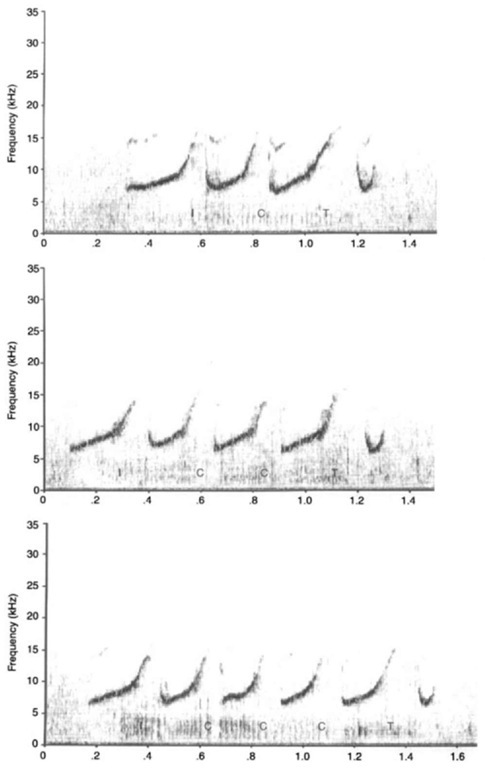Signature whistles were first described for several species of captive delphinids by David and Melba Caldwell in the 1960s. They found that individual dolphins, while isolated for medical attention, produced primarily one stereotyped individually distinctive whistle contour (Fig. 1). Other researchers had speculated that dolphin whistles might be context specific, i.e., with certain contours being produced in times of distress or to indicate the presence of food. However, it was difficult to support or refute these claims as dolphins do not make any visible movement associated with vocalization; thus it is not possible to identify who is vocalizing within a group. By recording individual dolphins in captivity, the Caldwells were able to get around this problem. Signature whistles have now been documented in more than 300 individual dolphins in a variety of locations, both captive and wild.
Since the Caldwells’ pioneering work, most work on signature whistles has focused on the bottlenose dolphin, Tursiops truncatus, and it has focused on four major questions. First, do sounds produced during isolation occur in the typical vocal repertoire of dolphins? Second, how do signature whistles function in the natural communication system of dolphins? Third, what is the role of whistle copying in the natural communication system of dolphins? Fourth, how do signature whistles develop in young animals?
The first two of these questions were raised in a study of 10 captive dolphins by McCowan and Reiss (1995), in which no evidence was found for stereotyped signature whistles. However, Janik and Slater (1998) found that captive dolphins tended to produce signature whistles primarily when one group member was voluntarily isolated from the rest of the group. Their study provided strong support for the use of signature whistles as cohesion calls, a finding that was also supported by a study of wild dolphins by Smolker and colleagues (1993). Thus, dolphins that are in close proximity and in visual contact, such as in the McCowan and Reiss study, may not need to produce sig nature whistles. Playback experiments with temporarily captured dolphins in Sarasota, Florida, also showed that dolphins can discriminate among different signature whistles and that they are thus likely to function in individual recognition (Sayigh et al, 1999). Again, for captive dolphins that are housed in close proximity to one another, there may be little need for such a function.
Additional evidence in support of the idea that whistles produced during isolation also occur in the typical vocal repertoire of dolphins came from a study of vocal production in free-ranging dolphins in Sarasota, Florida (Hill and Sayigh, 1999). Approximately 50% of whistles produced during normal activities matched signature whistles that had been produced by the same individuals during temporary capture. The other 50% of whistles were comprised by various contours, many of which took on the general form of an upsweep. The functions of these whistles are unknown.
The first study to address copying, or imitation, of signature whistles was conducted by Peter Tyack (1986). He used a telemetry device called a “vocalight,” which dolphins wore on their heads and which lit up when a sound was produced, and found that socially interactive dolphins not only produce signature whistles, but that they also produce imitations of each other’s signature whistles. Such copying of signature whistles has now been documented in several other studies. Two of these studies (Smolker and Pepper, 1999; Watwood et al, 1999) have found that close male associates tend to converge on a similar whistle type. New technologies that enable localization of vocalizing animals are necessary to study how both signature and nonsignature whistles (including whistle copies) are used in the natural communication system of dolphins.
In addition to discovering signature whistles, David and Melba Caldwell were the first researchers to investigate vocal development in bottlenose dolphins. They found that young dolphins produce tremulous, quavery whistles and then gradually converge on a stereotyped whistle contour during their first year of life. This contour then usually remains stable throughout the life of the animal. In a study of signature whistles produced bv dolphins in Sarasota, Florida, Sayigh et al. (1990, 1995) found that female calves tended to produce whistles that were highly distinct from those of their mothers. Males were more likely than females to produce whistles similar to those of their mothers. These findings raised the possibility that dolphins may be learning their signature whistles from conspecifics.
Much evidence now supports the idea that dolphins learn their signature whistles, which sets them apart from many other nonhuman mammals, in which vocal production is largely innate. However, little is known about what factors govern the “choice” of whistle contours by calves. Again, studies that utilize acoustic localization with concurrent behavioral observations promise to shed light on this interesting question.
Signature whistles are an important class of vocalizations produced by bottlenose dolphins. They function both in individual recognition and in maintaining group cohesion, and they appear to be learned. Much work remains to be done in order to learn how these whistles develop and how they are used in the natural communication system of dolphins.
Figure 1 Examples of a “multilooped” signature whistle of an adult female bottlenose dolphin recorded during temporary capture in Sarasota, Florida, in 1984. Her whistle typically consists of an introductory loop (labeled “I”), a terminal loop (labeled “T”), and a varying number of central loops (labeled “C”). Shown are whistles with one, two, and three central loops. Spectrograms were made with SIGNAL (Engineering Design, Belmont, MA) at a sample rate of 80,000 Hz and a 512 point FFT.

